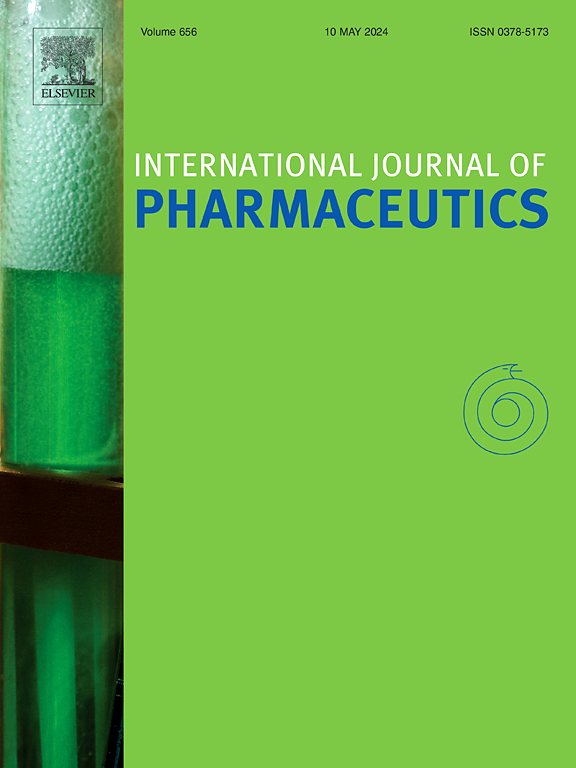研究通过共凝固法制造微球的相分离步骤中的关键因素。
IF 5.3
2区 医学
Q1 PHARMACOLOGY & PHARMACY
引用次数: 0
摘要
凝聚法是制备微球的一种常用方法,但尚未得到足够的重视和研究。本研究旨在阐明相分离步骤中的关键因素。首先,根据聚合物溶液的热力学,确定了相平衡时间、双顶线以及共凝胶相(CPLGA)中乳酸-乙醇酸共聚物(PLGA)浓度与 PLGA-瘦相(CPDMS)中聚二甲基硅氧烷(PDMS)浓度之间的关系。研究发现,乳酸:乙醇比率(L:G)对相分离有显著影响,我们还介绍了一种方法,用于计算由聚乳酸乙烯-丙烯酸甲酯(PLGA)、聚二甲基硅氧烷(PDMS)和二氯甲烷(DCM)组成的体系相分离后的凝聚相和聚乳酸乙烯-丙烯酸甲酯(PLGA)瘦相的成分和质量。此外,还设计了一些旨在生产窄粒度分布微球的叶轮,并利用计算流体动力学(CFD)对搅拌状态进行了直观分析,解释了叶轮类型以及叶轮与容器之间的间隙对粒度分布的影响。对凝聚相和连续相粘度的测量,结合乳液理论,阐明了乳液在相分离步骤中的行为,同时也强调了制备窄粒度分布微球的关键在于减弱凝聚相液滴的凝聚。最后,体外释放证明了 CPLGA 和凝聚态液滴的粒度分布是相分离步骤的关键因素。本文章由计算机程序翻译,如有差异,请以英文原文为准。
Investigating key factors in the phase separation step of microspheres fabrication via coacervation
Coacervation, a common method for microspheres preparation, has not been given sufficient attention and study. This study aims to clarify the key factors in the phase separation step. Firstly, based on the thermodynamics of polymer solutions, the phase equilibrium time, binodal line, and the relationship between the concentration of lactic-glycolic acid copolymer (PLGA) in the coacervate phase (CPLGA) and the concentration of polydimethylsiloxane (PDMS) in the PLGA-lean phase (CPDMS) were determined. It was found that the lactic:glycolic ratio (L:G) significantly influences phase separation, and we introduced a method to calculate the compositions and masses of both the coacervate and PLGA-lean phases after phase separation of a system composed of PLGA, PDMS, and dichloromethane (DCM). Furthermore, some impellers aimed at producing narrow size distribution microspheres were designed, and the stirring states were analyzed visually using Computational Fluid Dynamics (CFD), explaining the impact of impeller types and clearance between impeller and vessel on particle size distribution. Measurements of the viscosities of the coacervate and continuous phases, coupled with emulsion theories, clarified the behavior of emulsion during the phase separation step, while also highlighting that the key to preparing narrow size distribution microspheres lies in weakening the coalescence of coacervate droplets. Finally, in vitro release demonstrated that CPLGA and the particle size distribution of coacervate droplets are key factors in the phase separation step.
求助全文
通过发布文献求助,成功后即可免费获取论文全文。
去求助
来源期刊
CiteScore
10.70
自引率
8.60%
发文量
951
审稿时长
72 days
期刊介绍:
The International Journal of Pharmaceutics is the third most cited journal in the "Pharmacy & Pharmacology" category out of 366 journals, being the true home for pharmaceutical scientists concerned with the physical, chemical and biological properties of devices and delivery systems for drugs, vaccines and biologicals, including their design, manufacture and evaluation. This includes evaluation of the properties of drugs, excipients such as surfactants and polymers and novel materials. The journal has special sections on pharmaceutical nanotechnology and personalized medicines, and publishes research papers, reviews, commentaries and letters to the editor as well as special issues.

 求助内容:
求助内容: 应助结果提醒方式:
应助结果提醒方式:


